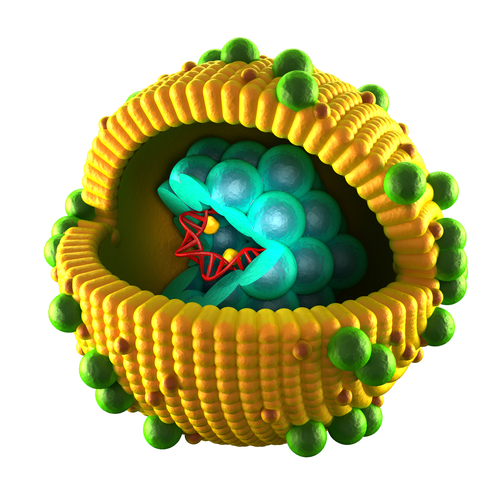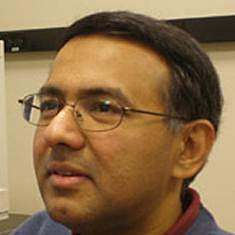High-Resolution 3D Images Reveal Muscle Mitochondrial Power Grid

Findings of a new study are overturning longstanding scientific theories about how energy is distributed within muscles for powering movement. Researchers at the National Institutes of Health report the first clear evidence that muscle cells distribute energy primarily by the rapid conduction of electrical charges through a vast, interconnected network of mitochondria — the cells’ powerhouse, if you will — in a way resembling the wire grid that distributes power throughout a city. The study provides an unprecedented, detailed window showing scientists how the system that rapidly distributes energy throughout the cell to power muscle contraction functions. These observations solve the problem of how muscles rapidly distribute energy in the cells for movement.
The researchers who achieved the results using state-of-the-art imaging technologies at the National Institutes of Health’s National Heart, Lung, and Blood Institute (NHLBI) and the National Cancer Institute (NCI) in Bethesda, Maryland, suggest that this new information may lead to a better understanding of many diseases linked to energy utilization in the heart and skeletal muscle, such as heart disease, mitochondrial diseases, and muscular dystrophy.
“The discovery of this mechanism for rapid distribution of energy throughout the muscle cell will change the way scientists think about muscle function and will open up a whole new area to explore in health and disease,” says Robert S. Balaban, Ph.D. Scientific Director of NHLBI’s Division of Intramural Research and chief of NHLBI’s Laboratory of Cardiac Energetics in a NIH release. Dr. Balaban is the study’s co-principal investigator along with his colleague Sriram Subramaniam, Ph.D. , a researcher with NCIs Laboratory of Cell Biology. The landmark study is the featured cover article in the July 30 print issue of the journal Nature, entitled: “Mitochondrial reticulum for cellular energy distribution in muscle“ (Nature 523, 617–620 (30 July 2015) doi:10.1038/nature14614), coauthored by Brian Glancy, Daniela Malide, Zu-Xi Yu, Christian A. Combs, Patricia S. Connelly, and Robert S. Balaban of the National Heart Lung and Blood Institute; with Lisa M. Hartnell and Sriram Subramaniam of the National Cancer Institute — both departments of the National Institutes of Health at Bethesda, Maryland.
In their study, the scientists’ objective was to investigate how energy is distributed within the cell, noting that in the skeletal muscle, intracellular energy distribution has attracted much scientific interest and has been proposed to occur in skeletal muscles via metabolite-facilitated diffusion or the slow spread of the end products of oxidative phosphorylation, including ATP and other compounds, through the crowded cell. However, recent genetic research findings suggest that diffusion alone does not fully support the distribution of energy in heart and skeletal muscle cells, casting doubt on the significance of this distribution mode, suggesting that facilitated diffusion is not critical for normal function energy distribution. Researchers had suspected that a faster, more efficient energy pathway might exist but have found little proof of its existence until now.
Hypothesizing that mitochondrial structure minimizes metabolite diffusion distances in skeletal muscle, and by employing various forms of high-resolution microscopy, Dr. Balaban and his research colleagues explored whether the mitochondria themselves — as well as actually generating the energy — also have a role in its distribution. They found that they do, and were able to demonstrate a mitochondrial reticulum providing a conductive pathway for energy distribution, in the form of the proton-motive force, throughout the mouse skeletal muscle cell. Within this reticulum, they found proteins associated with mitochondrial proton-motive force production preferentially in the cell periphery, and proteins that use the proton-motive force for ATP production in the cell interior near contractile and transport ATPases by forming a conductive pathway throughout the cell in the form of a proton-motive force. Throughout this network, the mitochondrial protein localization seems to be varied, allowing optimized generation and utilization of the mitochondrial membrane potential. This energy distribution network, which depends on conduction rather than diffusion, is potentially extremely rapid, thereby enabling muscle to respond almost instantaneously to new energy demands.
Dr. Balaban explains that millions of years ago, a eukaryotic cell swallowed whole the bacterial ancestor of the mitochondrion and put it to work converting nutrients into energy. He notes that creating energy is an inherently dangerous process requiring careful monitoring and quick eradication of damaging byproducts, and that cells therefore have mitochondrial function under tight regulatory control, noting that since his discovery some years ago that mitochondria in the heart can supply energy at a rate that perfectly matches a range of physiological demands, he has sought to understand how mitochondria are regulated to ensure this metabolic homeostasis.
Dr. Balaban bases his research on the hypothesis that mitochondria are modulated to support cellular metabolic homeostasis chronically by altering mitochondrial content, composition, and cellular location. Given the complexity of the mitochondrial proteome, he says it is it is clear that the focus must be on regulatory networks and manipulations of functional pathways, not on a few lone proteins. Accordingly, the Balaban laboratory takes a systems approach to studying mitochondrial protein composition and distribution in relation to function. He and his colleagues study post-translational modifications of mitochondrial proteins to understand how proteins and enzymes rapidly adjust to maintain metabolic homeostasis under acute changes in energy demand.
Dr. Balaban’s efforts to reconstitute the information gained from these proteomics approaches into a picture of mitochondrial regulation are based on models of energetic flux that make relatively simple assumptions about the relationship of enzyme concentration to reaction velocity. Complementing biochemical, proteomics-based, and computational approaches, Dr. Balaban’s laboratory studies the changes in mitochondria that occur in vivo. Dr. Subramaniam explains that the long-term mission of his research program is to obtain an integrated, quantitative understanding of cells and viruses at molecular resolution. He and his colleagues take an interdisciplinary approach to this problem by combining novel technologies for three-dimensional (3D) imaging with computational and cell biological tools. Their research efforts are presently focused on three areas: (1) determination of the structure and mechanisms underlying neutralization and cellular entry of HIV, (2) the development of automated, high-throughput workflows for structure determination of small, dynamic molecular complexes, and (3) the development of novel technologies for 3D imaging of cells and tissues, with particular emphasis on methods for understanding and diagnosing structural signatures of signal transduction and disease progression.
For their current experiments, the NIH scientists collaborated in a detailed study of the mitochondria structure, biochemical composition, and function in mouse skeletal muscle cells. Using 3D electron microscopy in conjunction with super-resolution optical imaging techniques, the researchers were able to show that most mitochondria form highly connected networks in a way that resembles electrical transmission lines in the aforementioned municipal power grid metaphor.
Movement of muscles, from flexing of arms and fingers to the pumping of the heart, requires plenty of energy that must be distributed throughout the cell. For example, the skeletal muscle rate of energy utilization can increase 100-fold with strenuous exercise. As a result, muscle cells contain many mitochondria, which are microscopic structures specially equipped to convert foods, including sugars and fats, into useable high-energy molecules, particularly adenosine triphosphate (ATP), to supply the energy required for work. As part of this process, known as oxidative phosphorylation, the mitochondria, acting like small cellular batteries, use an electrical voltage across their membranes as an intermediate energy source in converting food into ATP. Consequently, this mitochondrial membrane voltage can be considered one of the primary sources of energy in the cell.
After using high-resolution 3D images to reveal the structure of the mitochondrial power grid, the scientists used specially designed optical probes to subsequently demonstrate that these mitochondrial wires were electrically conductive. Using these probes, the researchers were able to demonstrate that most of the mitochondria were in direct electrical communication through the interconnecting network, demonstrating that mitochondria are electrically coupled and can rapidly distribute the mitochondrial membrane voltage the primary energy for ATP production throughout the cell.
The study provides unprecedented images of how these mitochondria are arranged in muscle — structurally arranged in such a way that permits the flow of potential energy in the form of the mitochondrial membrane voltage throughout the cell to power ATP production and subsequent muscle contraction, or movement, Dr. Balaban explains, adding that “mitochondria located on the edges of the muscle cell near blood vessels and oxygen supply are optimized for generating the mitochondrial membrane voltage, while the interconnected mitochondria deep in the muscle are optimized for using the voltage to produce ATP.”
“These observations solve the problem of how muscle rapidly distributes energy in the cell for movement,” Dr. Balaban continues. “The findings also challenge the older model that energy is distributed by the slow diffusion of high-energy molecules through the remarkably dense muscle cell.”
Use of a focused-ion beam scanning electron microscopy technique called FIB-SEM played a critical role in unraveling the 3D architecture of mitochondrial networks in these muscle cells. Dr. Subramaniam and his colleagues were the first to develop and use this imaging approach almost a decade ago to image cells and tissue.
 “We originally developed these biological imaging methods to explore mechanisms of HIV-1 infection and structural changes in melanoma cells,” says Dr. Subramaniam. “It is very satisfying to see how the methods are now useful in a completely different sphere of biology with this interdisciplinary collaboration.”
“We originally developed these biological imaging methods to explore mechanisms of HIV-1 infection and structural changes in melanoma cells,” says Dr. Subramaniam. “It is very satisfying to see how the methods are now useful in a completely different sphere of biology with this interdisciplinary collaboration.”
The investigators conclude that identifying this basic property of the muscle cell in how it distributes energy has potential implications for disease diagnosis and treatment, suggesting that their findings could spark new avenues of scientific and medical research, and that in the future, scientists may use muscle biopsies or sophisticated non-invasive imaging techniques to determine how defects in mitochondrial networks impact different diseases.
Part of the National Institutes of Health, the National Heart, Lung, and Blood Institute (NHLBI) plans, conducts, and supports research related to the causes, prevention, diagnosis, and treatment of heart, blood vessel, lung, and blood diseases; and sleep disorders. The Institute also administers national health education campaigns.
The National Cancer Institute leads the National Cancer Program and the NIHs efforts to dramatically reduce the prevalence of cancer and improve the lives of cancer patients and their families, through research into prevention and cancer biology, the development of new interventions, and the training and mentoring of new researchers.
For more information, visit the NCI website at https://www.cancer.gov or call NCI’s Cancer Information Service at 1-800-4-CANCER.
For more information about NIH and its programs, visit:
https://www.nih.gov
Sources:
National Institutes of Health
Nature
Image Credits:
National Institutes of Health






